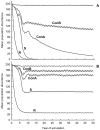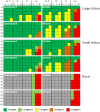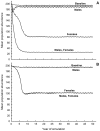Simulating free-roaming cat population management options in open demographic environments
- PMID: 25426960
- PMCID: PMC4245120
- DOI: 10.1371/journal.pone.0113553
Simulating free-roaming cat population management options in open demographic environments
Erratum in
-
Correction: simulating free-roaming cat population management options in open demographic environments.PLoS One. 2015 Mar 16;10(3):e0119390. doi: 10.1371/journal.pone.0119390. eCollection 2015. PLoS One. 2015. PMID: 25774873 Free PMC article. No abstract available.
Abstract
Large populations of free-roaming cats (FRCs) generate ongoing concerns for welfare of both individual animals and populations, for human public health, for viability of native wildlife populations, and for local ecological damage. Managing FRC populations is a complex task, without universal agreement on best practices. Previous analyses that use simulation modeling tools to evaluate alternative management methods have focused on relative efficacy of removal (or trap-return, TR), typically involving euthanasia, and sterilization (or trap-neuter-return, TNR) in demographically isolated populations. We used a stochastic demographic simulation approach to evaluate removal, permanent sterilization, and two postulated methods of temporary contraception for FRC population management. Our models include demographic connectivity to neighboring untreated cat populations through natural dispersal in a metapopulation context across urban and rural landscapes, and also feature abandonment of owned animals. Within population type, a given implementation rate of the TR strategy results in the most rapid rate of population decline and (when populations are isolated) the highest probability of population elimination, followed in order of decreasing efficacy by equivalent rates of implementation of TNR and temporary contraception. Even low levels of demographic connectivity significantly reduce the effectiveness of any management intervention, and continued abandonment is similarly problematic. This is the first demographic simulation analysis to consider the use of temporary contraception and account for the realities of FRC dispersal and owned cat abandonment.
Conflict of interest statement
Figures






References
-
- Levy JK, Crawford PC (2004) Humane strategies for controlling feral cat populations. J Amer Vet Med Assoc 225:1354–1360. - PubMed
-
- Turner DC, Bateson P (2000) The domestic cat: The biology of its behaviour. Cambridge, England: Cambridge University Press. 244 p.
-
- Chu K, Anderson WM, Rieser MY (2009) Population characteristics and neuter status of cats living in households in the United States. J Amer Vet Med Assoc 234:1023–1030. - PubMed
-
- Patronek GJ (2010) Mapping and measuring disparities in welfare for cats across neighborhoods in a large U.S. city. Amer J Vet Res 71:161–168. - PubMed
-
- Centers for Disease Control and Prevention (2004) Toxoplasmosis: an important message for cat owners. Atlanta, GA: CDC. 2 pp.
Publication types
MeSH terms
LinkOut - more resources
Full Text Sources
Other Literature Sources
Miscellaneous

